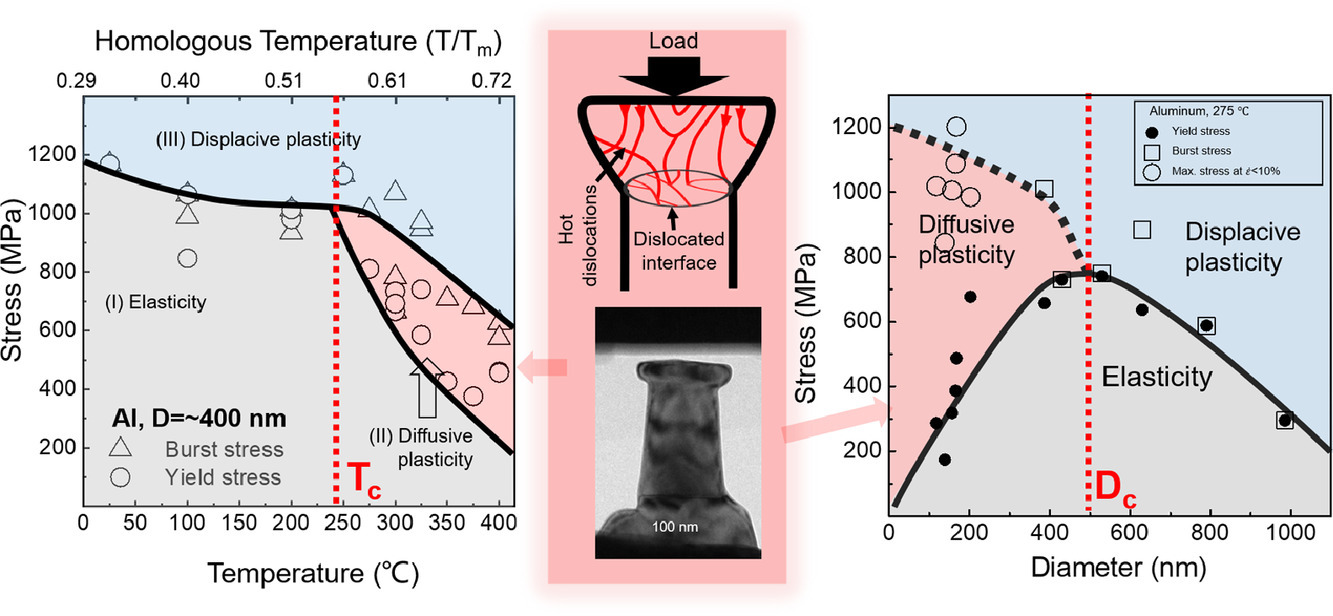Deformation mechanism map (DMM) is vital important for the design and fabrication of metal components with high performance and long service life. As early as 1972, Ashby has developed the DMMs of bulk metal materials to reveal the evolution of deformation mechanisms with strain rate, temperature and stress. With the miniaturization of functional devices, such as chips, micro-sensors, and micro-electromechanical systems (MEMS), more and more metal-based functional components are used at sub-micron scale. In the actual service, these components above always are subjected to the coupled influence of temperature and stress. However, different from bulk materials in macro scale, the deformation mechanism of metal below micro scale is also related to the apparent size of devices, which means that it is necessary to construct the deformation mechanism maps for metals in micro scale precisely, to help the implementation of the sub-micron metals. Therefore, the first thing we should do is to develop a kind of technique that can efficiently tell the deformation mechanisms for small scale samples. For a decade of exploration, Zhiwei Shan’s research team make it by developing an in-situ high temperature quantitative nanomechanical testing technique based on the transmission electron microscope, which is applied to test the single crystal aluminum samples of 150-1000 nm at temperatures ranging from 25 ℃ to 400 ℃. These experimental data results in the construction of the DMMs of sub-micron aluminum (as shown in Fig.1).

Figure 1 DMMs of sub-μm single crystal aluminum
The metal deformation mechanism varies with the temperature and sample size. across a certain critical temperature Tc, the dominant deformation mechanism will change from displacive type (dislocation and twin) to diffusive type (as shown in Fig.1, left part). At the temperature below Tc, the plastic deformation is mediated by dislocation motion, featuring with discontinuous flow containing strain burst along the slip direction. Beyond Tc, the deformation is dominated by diffusion mechanism, which is relatively continuous but localized within the top of the pillar, resulting in a mushroom shape at the top of the pillar sample. A unique characteristic of small-scale samples is that the deformation mechanism is also significantly affected by sample size. In stress-sample-size DMM (as shown in Fig. 1, right part), there exists a “strongest size” at the triple point of three regions, above which “smaller is stronger” and below which “smaller is weaker”. Meanwhile, in the diffusive-plasticity-dominated regime, deformation is localized within the top of pillar, with an obvious interface between the deformed and undeformed parts (as shown in Fig 1, middle part). The DMMs above will help researchers and designers to identify dominant deformation mechanism, the critical condition of mechanism transition and the “strongest size” in a particular condition.
This work is published in the journal Acta Materialia under the title-Deformation mechanism maps for sub-micron sized aluminum. Degang Xie, Associated Professor of Xi’an Jiaotong University, is the first author of the paper, and Ju Li, Professor of Massachusetts institute of technology, and Zhiwei Shan, Professor of Xi’an Jiaotong University, are the co-corresponding authors of the paper. Also involved in this work are Professor Shigenbu Ogata of Osaka University in Japan, Professor Evan Ma of Johns Hopkins University, Graduated student Rongrong Zhang of Xi’an Jiaotong University (currently a Doctoral candidate at the National institute of applied Sciences in Lyon, France), Doctoral candidate Zhiyu Nie and Master candidate Jing Li. The research is jointly funded by the National Key Research and Development Program of China, the National Natural Science Foundation of China, the Shaanxi Postdoctoral Science Foundation and the Natural Science Foundation of Shaanxi Province.
Link: https://www.sciencedirect.com/science/article/pii/S1359645420301178
Center for Advancing Materials Performance from the Nanoscale, CAMP-Nano is committed to systematically and quantitatively construct the knowledge and theoretical system of sub-micron scale materials, to establish a solid theoretical foundation and methodological guidance for its large-scale industrial application. Since 2010, the center has published more than 190 signed articles, including papers in well-known journals such as 2 papers in Nature, 5 papers in Science, 3 papers in Nature Materials, 11 papers in Nature Communications, 3 papers in Advanced Materials, 14 papers in Nano Letters, 3 papers in Physical Review Letters, and 42 patents. This research relies on the newly developed in situ force-thermal coupling test technology of sub-micron scale, which is expected to make a series of breakthrough findings in the field of sub-micron scale high temperature mechanics, and lay a foundation for the further understanding of sub-micron materials’ performance.


